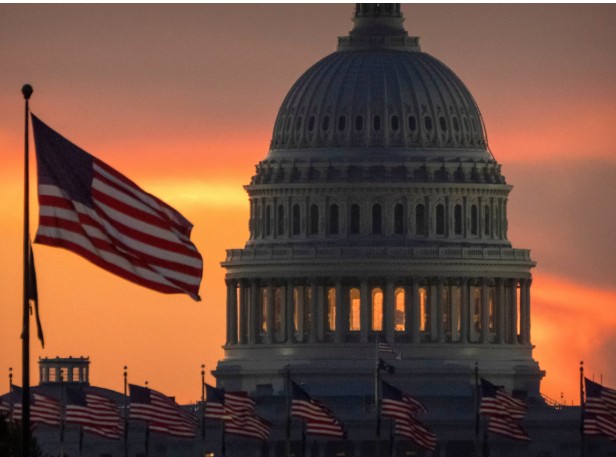The 2025 U.S. federal government shutdown kicked off on October 1, 2025, when Congress couldn’t agree on a continuing resolution (CR) to keep the lights on for fiscal year 2026. This mess stemmed from the expiration of prior funding deals, leaving about 900,000 federal workers furloughed and another two million clocking in without pay. Essential services like Medicare, Defense, and TSA kept humming, but the whole ordeal dragged on for a record-breaking 42 days—longer than the 2018-2019 shutdown under Trump’s first term. Now, we’ve seen these shutdowns before: they’re fiscal theatre that rattles markets, delays payments, and piles on unnecessary economic drag. This one was no different, with GDP estimates taking a hit of about 0.1% per week, not to mention the backlog in services like IRS processing and small business loans.
The core fight boiled down to spending priorities in a divided government. Republicans, controlling the White House and pushing for fiscal restraint, wanted a “clean” CR without bells and whistles—essentially funding at current levels while eyeing rescissions to claw back billions in foreign aid and public broadcasting funds. Democrats, on the other hand, dug in their heels over extending Affordable Care Act (ACA) subsidies set to expire at year’s end, which would jack up premiums for millions. They also opposed any mass layoffs or impoundments that could slim down the federal bureaucracy. From my vantage point, this was classic big-government vs. lean-government clash: Repubs aiming to cut fat, Dems fighting to expand the welfare state.
How the Shutdown Ended
The shutdown wrapped up on November 10, 2025, after the Senate hammered out a bipartisan deal and passed it 60-40, with a handful of Democrats (eight, to be exact) crossing the aisle to join Republicans. Key players like Senators Jeanne Shaheen, Maggie Hassan, and Angus King helped broker it, showing that even in polarized times, some sanity can prevail. The bill extends funding at existing levels through January 30, 2026, includes full-year appropriations for military construction, veterans affairs, the legislative branch, and agriculture, and skips Trump’s proposed cuts for now. It also guarantees a Senate vote in December on those ACA subsidies, funds SNAP (food stamps) through September 2026, rehires laid-off workers with back pay, and blocks mass layoffs until the new year. The House, under Speaker Mike Johnson, is set to vote soon after reconvening from recess, and Trump is expected to sign it—ending the 41-42 day saga (depending on how you count the overlap).
Financially, this resolution averts deeper damage: stock markets dipped about 2-3% during the height of uncertainty, Treasury yields spiked on debt ceiling fears (even though that wasn’t directly in play), and consumer confidence took a nosedive. But with it over, expect a quick rebound—businesses despise uncertainty more than anything.
The Democrats’ Public Strategy – All Smoke, No Fire
On the surface, Democrats framed the shutdown as Republican extremism run amok. Senate Minority Leader Schumer thundered about “Trump’s tantrum” endangering veterans and air traffic controllers, while House Dems like Greg Stanton decried the “GOP’s refusal to govern.” Their filibuster threats in the Senate stalled progress, demanding “bipartisan protections” for federal workers and programs. But here’s the tell: When push came to shove, those eight Dem senators (including moderates like Tim Kaine and Maggie Hassan) flipped without extracting concessions on healthcare expansions or green energy slush funds. Hassan cited “deep pain” from constituents, but it was really the polls tanking—shutdown fatigue hit hard in swing states. Strategy? Delay, demonize, and defect when the heat got too high. Classic D.C. theater. The one thing this government shutdown has exposed is the complete and utter FAILURE of Obamacare. This disaster, which is basically one big money laundering scheme, was unleashed on America by Democrats.
The Democratic Party’s Strategy and Real End Game
The root of the shutdown lay in partisan gridlock over a “clean” continuing resolution. Republicans, controlling the White House under President Trump, the House, and the Senate, pushed for a straightforward extension without new spending commitments, aiming to curb what they saw as wasteful outlays through rescissions (clawing back prior funds, like $9 billion in foreign aid). Democrats, however, held firm, demanding extensions of ACA enhanced subsidies set to expire at year’s end, which they argued were critical to prevent premium hikes for millions. This led to repeated failed votes in September and October, with Democrats blocking GOP proposals multiple times.
In my view, the Democrats’ real end game wasn’t just about healthcare— it was a calculated play to entrench big-government entitlements and force Republicans into concessions that balloon the deficit. By prolonging the shutdown, they shifted public blame onto Trump and the GOP (polls showed increasing fault on Republicans), while securing a future vote on ACA expansions that could add trillions to long-term spending.
The Eight Democrats ultimately broke ranks to pass the bill, but only after extracting guarantees like the ACA vote and protections against layoffs—classic progressive tactics to expand the welfare state under the guise of crisis resolution. Fiscally, this sets a dangerous precedent: rewarding obstruction with more borrowing, ignoring the national debt that’s already over $35 trillion. Republicans should push for real reforms, like tying funding to spending caps or entitlement overhauls, to prevent future shutdowns from becoming tools for leftist agenda-pushing. Trump, nailed it: this was about punishing political foes and advancing a radical left agenda under the guise of “protecting healthcare.”
Reflections on the Recent Mayoral Elections
The off-year elections on November 4, 2025, saw several high-profile mayoral races, with Democrats largely sweeping urban centres in what some called an early referendum on the Trump administration. In New York City, progressive Democrat Zohran Mamdani won, defeating independent Andrew Cuomo (who lost the primary), Republican Curtis Sliwa, and incumbent Eric Adams in a fragmented field. Other cities followed suit, with Democratic victories in places like Boston and potentially others, reinforcing blue control in major metros. MSNBC admitted the quiet part out loud about Democrat logic on the government shutdown.
Written By tatenda Belle Panashe



